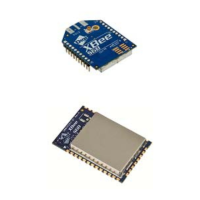XBee® Wi-Fi RF Modules
© 2013 Digi International, Inc. 121
Systems Interconnection (OSI) communication model, TCP is in layer 4, the Transport
Layer.
UDP
See User Datagram Protocol.
User Datagram Protocol (UDP)
A communications protocol that offers a limited amount of service when messages are
exchanged between computers in a network that uses the Internet Protocol (IP). UDP is
an alternative to the Transmission Control Protocol (TCP) and, together with IP, is
sometimes referred to as UDP/IP. Like the Transmission Control Protocol, UDP uses
the Internet Protocol to actually get a data unit (called a datagram) from one computer
to another. Unlike TCP, however, UDP does not provide the service of dividing a
message into packets (datagrams) and reassembling it at the other end. Specifically,
UDP does not provide sequencing of the packets in which the data arrives, nor does it
guarantee delivery of data. This means that the application program that uses UDP must
be able to make sure that the entire message has arrived and is in the right order.
Network applications that want to save processing time because they have very small
data units to exchange (and therefore very little message reassembling to do) may prefer
UDP to TCP. The Trivial File Transfer Protocol (TFTP) uses UDP instead of TCP.
UDP provides two services not provided by the IP layer. It provides port numbers to
help distinguish different user requests and, optionally, a checksum capability to verify
that the data arrived intact.
Wi-Fi Protected Access (WPA)
A data encryption/ user authentication method for 802.11 wireless LANs. WPA uses the
Temporal Key Integrity Protocol (TKIP).
Wired Equivalency Protocol (WEP)
A security algorithm that uses an RC4 stream cipher, but which has multiple known flaws.
WPA
See Wi-Fi Protected Access.
WPA2/802.11i
WPA with AES-based encryption (CCMP)

